Operating System - Virtual Memory
Virtual memory is a technique that allows the execution of processes which are not completely available in memory. The main visible advantage of this scheme is that programs can be larger than physical memory. Virtual memory is the separation of user logical memory from physical memory.
This separation allows an extremely large virtual memory to be provided for programmers when only a smaller physical memory is available. Following are the situations, when entire program is not required to be loaded fully in main memory.
User written error handling routines are used only when an error occured in the data or computation.
Certain options and features of a program may be used rarely.
Many tables are assigned a fixed amount of address space even though only a small amount of the table is actually used.
The ability to execute a program that is only partially in memory would counter many benefits.
Less number of I/O would be needed to load or swap each user program into memory.
A program would no longer be constrained by the amount of physical memory that is available.
Each user program could take less physical memory, more programs could be run the same time, with a corresponding increase in CPU utilization and throughput.
Virtual Memory
Virtual memory is commonly implemented by demand paging. It can also be implemented in a segmentation system. Demand segmentation can also be used to provide virtual memory.
Demand Paging
A demand paging system is quite similar to a paging system with swapping. When we want to execute a process, we swap it into memory. Rather than swapping the entire process into memory, however, we use a lazy swapper called pager.
When a process is to be swapped in, the pager guesses which pages will be used before the process is swapped out again. Instead of swapping in a whole process, the pager brings only those necessary pages into memory. Thus, it avoids reading into memory pages that will not be used in anyway, decreasing the swap time and the amount of physical memory needed.
Hardware support is required to distinguish between those pages that are in memory and those pages that are on the disk using the valid-invalid bit scheme. Where valid and invalid pages can be checked by checking the bit. Marking a page will have no effect if the process never attempts to access the page. While the process executes and accesses pages that are memory resident, execution proceeds normally.
Demand Paging
Access to a page marked invalid causes a page-fault trap. This trap is the result of the operating system's failure to bring the desired page into memory. But page fault can be handled as following
Page Fault
Steps
Step 1 Check an internal table for this process, to determine whether the reference was a valid or it was an invalid memory access.
Step 2 If the reference was invalid, terminate the process. If it was valid, but page have not yet brought in, page in the latter.
Step 3 Find a free frame.
Step 4 Schedule a disk operation to read the desired page into the newly allocated frame.
Step 5 When the disk read is complete, modify the internal table kept with the process and the page table to indicate that the page is now in memory.
Step 6 Restart the instruction that was interrupted by the illegal address trap. The process can now access the page as though it had always been in memory. Therefore, the operating system reads the desired page into memory and restarts the process as though the page had always been in memory.
ADVANTAGES
Following are the advantages of Demand Paging
Large virtual memory.
More efficient use of memory.
Unconstrained multiprogramming. There is no limit on degree of multiprogramming.
DISADVANTAGES
Following are the disadvantages of Demand Paging
Number of tables and amount of processor overhead for handling page interrupts are greater than in the case of the simple paged management techniques.
Due to the lack of an explicit constraints on a jobs address space size.
Page Replacement Algorithm
Page replacement algorithms are the techniques using which Operating System decides which memory pages to swap out, write to disk when a page of memory needs to be allocated. Paging happens whenever a page fault occurs and a free page cannot be used for allocation purpose accounting to reason that pages are not available or the number of free pages is lower than required pages.
When the page that was selected for replacement and was paged out, is referenced again then it has to read in from disk, and this requires for I/O completion. This process determines the quality of the page replacement algorithm: the lesser the time waiting for page-ins, the better is the algorithm. A page replacement algorithm looks at the limited information about accessing the pages provided by hardware, and tries to select which pages should be replaced to minimize the total number of page misses, while balancing it with the costs of primary storage and processor time of the algorithm itself. There are many different page replacement algorithms. We evaluate an algorithm by running it on a particular string of memory reference and computing the number of page faults.
Reference String
The string of memory references is called reference string. Reference strings are generated artificially or by tracing a given system and recording the address of each memory reference. The latter choice produces a large number of data, where we note two things.
For a given page size we need to consider only the page number, not the entire address.
If we have a reference to a page p, then any immediately following references to page p will never cause a page fault. Page p will be in memory after the first reference; the immediately following references will not fault.
For example, consider the following sequence of addresses - 123,215,600,1234,76,96
If page size is 100 then the reference string is 1,2,6,12,0,0
First In First Out (FIFO) algorithm
Oldest page in main memory is the one which will be selected for replacement.
Easy to implement, keep a list, replace pages from the tail and add new pages at the head.
First In First Out
Optimal Page algorithm
An optimal page-replacement algorithm has the lowest page-fault rate of all algorithms. An optimal page-replacement algorithm exists, and has been called OPT or MIN.
Replace the page that will not be used for the longest period of time . Use the time when a page is to be used.
Optimal page replacement
Least Recently Used (LRU) algorithm
Page which has not been used for the longest time in main memory is the one which will be selected for replacement.
Easy to implement, keep a list, replace pages by looking back into time.
Least Recently Used
Page Buffering algorithm
To get process start quickly, keep a pool of free frames.
On page fault, select a page to be replaced.
Write new page in the frame of free pool, mark the page table and restart the process.
Now write the dirty page out of disk and place the frame holding replaced page in free pool.
Least frequently Used(LFU) algorithm
Page with the smallest count is the one which will be selected for replacement.
This algorithm suffers from the situation in which a page is used heavily during the initial phase of a process, but then is never used again.
Most frequently Used(LFU) algorithm
This algorithm is based on the argument that the page with the smallest count was probably just brought in and has yet to be used.
Virtual memory is a technique that allows the execution of processes which are not completely available in memory. The main visible advantage of this scheme is that programs can be larger than physical memory. Virtual memory is the separation of user logical memory from physical memory.
This separation allows an extremely large virtual memory to be provided for programmers when only a smaller physical memory is available. Following are the situations, when entire program is not required to be loaded fully in main memory.
User written error handling routines are used only when an error occured in the data or computation.
Certain options and features of a program may be used rarely.
Many tables are assigned a fixed amount of address space even though only a small amount of the table is actually used.
The ability to execute a program that is only partially in memory would counter many benefits.
Less number of I/O would be needed to load or swap each user program into memory.
A program would no longer be constrained by the amount of physical memory that is available.
Each user program could take less physical memory, more programs could be run the same time, with a corresponding increase in CPU utilization and throughput.
Virtual Memory
Virtual memory is commonly implemented by demand paging. It can also be implemented in a segmentation system. Demand segmentation can also be used to provide virtual memory.
Demand Paging
A demand paging system is quite similar to a paging system with swapping. When we want to execute a process, we swap it into memory. Rather than swapping the entire process into memory, however, we use a lazy swapper called pager.
When a process is to be swapped in, the pager guesses which pages will be used before the process is swapped out again. Instead of swapping in a whole process, the pager brings only those necessary pages into memory. Thus, it avoids reading into memory pages that will not be used in anyway, decreasing the swap time and the amount of physical memory needed.
Hardware support is required to distinguish between those pages that are in memory and those pages that are on the disk using the valid-invalid bit scheme. Where valid and invalid pages can be checked by checking the bit. Marking a page will have no effect if the process never attempts to access the page. While the process executes and accesses pages that are memory resident, execution proceeds normally.
Demand Paging
Access to a page marked invalid causes a page-fault trap. This trap is the result of the operating system's failure to bring the desired page into memory. But page fault can be handled as following
Page Fault
Steps
Step 1 Check an internal table for this process, to determine whether the reference was a valid or it was an invalid memory access.
Step 2 If the reference was invalid, terminate the process. If it was valid, but page have not yet brought in, page in the latter.
Step 3 Find a free frame.
Step 4 Schedule a disk operation to read the desired page into the newly allocated frame.
Step 5 When the disk read is complete, modify the internal table kept with the process and the page table to indicate that the page is now in memory.
Step 6 Restart the instruction that was interrupted by the illegal address trap. The process can now access the page as though it had always been in memory. Therefore, the operating system reads the desired page into memory and restarts the process as though the page had always been in memory.
ADVANTAGES
Following are the advantages of Demand Paging
Large virtual memory.
More efficient use of memory.
Unconstrained multiprogramming. There is no limit on degree of multiprogramming.
DISADVANTAGES
Following are the disadvantages of Demand Paging
Number of tables and amount of processor overhead for handling page interrupts are greater than in the case of the simple paged management techniques.
Due to the lack of an explicit constraints on a jobs address space size.
Page Replacement Algorithm
Page replacement algorithms are the techniques using which Operating System decides which memory pages to swap out, write to disk when a page of memory needs to be allocated. Paging happens whenever a page fault occurs and a free page cannot be used for allocation purpose accounting to reason that pages are not available or the number of free pages is lower than required pages.
When the page that was selected for replacement and was paged out, is referenced again then it has to read in from disk, and this requires for I/O completion. This process determines the quality of the page replacement algorithm: the lesser the time waiting for page-ins, the better is the algorithm. A page replacement algorithm looks at the limited information about accessing the pages provided by hardware, and tries to select which pages should be replaced to minimize the total number of page misses, while balancing it with the costs of primary storage and processor time of the algorithm itself. There are many different page replacement algorithms. We evaluate an algorithm by running it on a particular string of memory reference and computing the number of page faults.
Reference String
The string of memory references is called reference string. Reference strings are generated artificially or by tracing a given system and recording the address of each memory reference. The latter choice produces a large number of data, where we note two things.
For a given page size we need to consider only the page number, not the entire address.
If we have a reference to a page p, then any immediately following references to page p will never cause a page fault. Page p will be in memory after the first reference; the immediately following references will not fault.
For example, consider the following sequence of addresses - 123,215,600,1234,76,96
If page size is 100 then the reference string is 1,2,6,12,0,0
First In First Out (FIFO) algorithm
Oldest page in main memory is the one which will be selected for replacement.
Easy to implement, keep a list, replace pages from the tail and add new pages at the head.
First In First Out
Optimal Page algorithm
An optimal page-replacement algorithm has the lowest page-fault rate of all algorithms. An optimal page-replacement algorithm exists, and has been called OPT or MIN.
Replace the page that will not be used for the longest period of time . Use the time when a page is to be used.
Optimal page replacement
Least Recently Used (LRU) algorithm
Page which has not been used for the longest time in main memory is the one which will be selected for replacement.
Easy to implement, keep a list, replace pages by looking back into time.
Least Recently Used
Page Buffering algorithm
To get process start quickly, keep a pool of free frames.
On page fault, select a page to be replaced.
Write new page in the frame of free pool, mark the page table and restart the process.
Now write the dirty page out of disk and place the frame holding replaced page in free pool.
Least frequently Used(LFU) algorithm
Page with the smallest count is the one which will be selected for replacement.
This algorithm suffers from the situation in which a page is used heavily during the initial phase of a process, but then is never used again.
Most frequently Used(LFU) algorithm
This algorithm is based on the argument that the page with the smallest count was probably just brought in and has yet to be used.

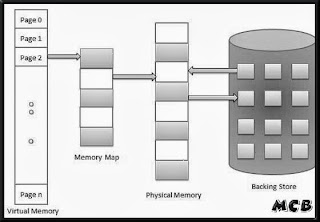
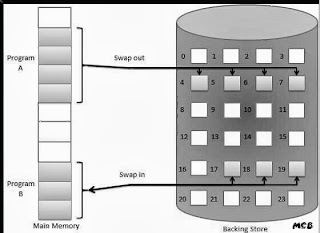
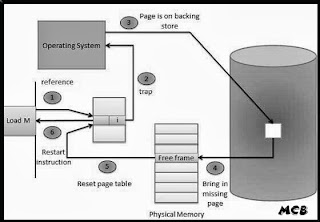

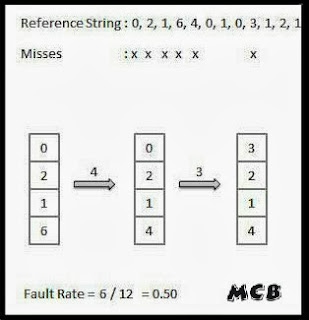
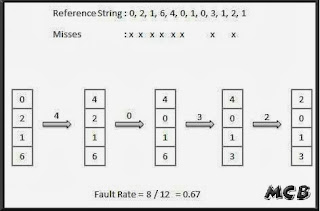
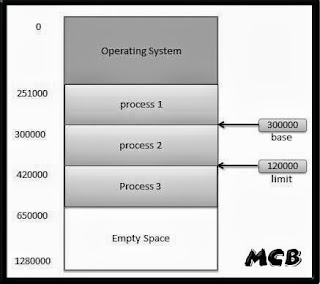
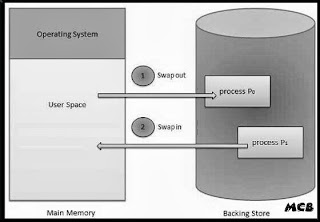
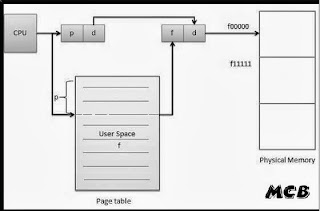
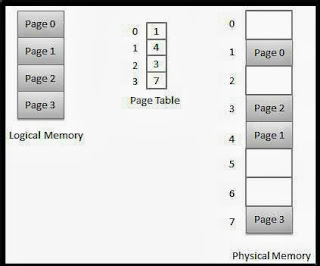
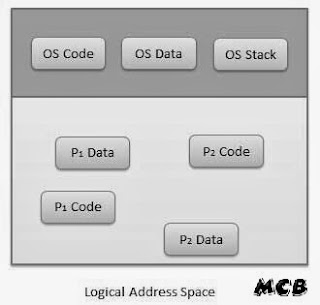

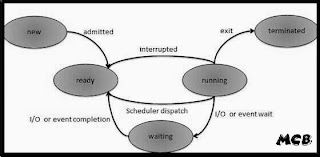

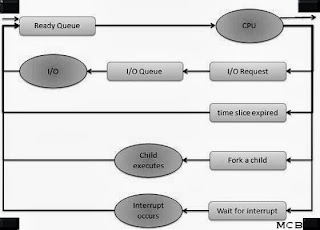
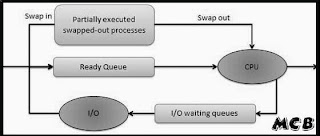
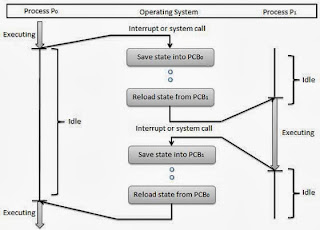
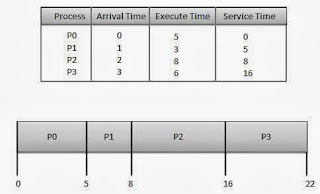.jpg)
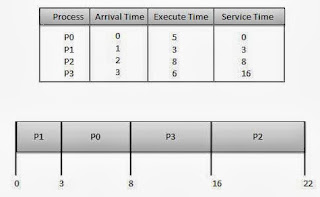.jpg)
.jpg)
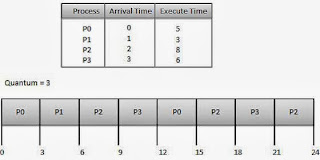.jpg)
.jpg)
